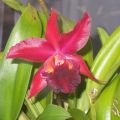


Donate Now
and become
Forum Supporter.

Many perks!
<...more...>


|

02-02-2009, 02:34 AM
|
|
Senior Member
|
|
Join Date: May 2007
Location: Kaohsiung, Taiwan
Posts: 4,267
|
|
 Cleisostoma paniculatum
Cleisostoma paniculatum
Cleisostoma paniculatum is found in east Asia and also in Taiwan. In this island, the wild plants usually grow on the trunks of big trees in mountainous areas.
I spotted some wild groups on big trees while going mountain climbing. Most plants of this species dewll so high that it is not easily for me to take clear close-up images for them. But it can usually be identified by their branched short spikes.

 |

02-02-2009, 09:26 AM
|
|
Senior Member
|
|
Join Date: Feb 2007
Zone: 9a
Location: Brooksville, Florida
Age: 62
Posts: 1,741
|
|
Awesome! I sure to wish that they grew on the trees here...
|

02-02-2009, 10:00 AM
|
 |
Senior Member
|
|
Join Date: Apr 2006
Zone: 9a
Location: Spring Hill, FL
Posts: 17,222
|
|
Now that is just way too cool! 
Thanks for sharing  |

02-02-2009, 12:21 PM
|
|
Senior Member
|
|
Join Date: May 2008
Location: Miami,FL
Age: 63
Posts: 2,574
|
|
WOW Id be mountain climbing too if I could go see vandas in the wild like that. Thanks a lot for showing these pics. I love them. Now you just need to take up tree climbing  |

02-02-2009, 10:30 PM
|
|
Senior Member
|
|
Join Date: May 2007
Location: Kaohsiung, Taiwan
Posts: 4,267
|
|
Thanks for looking. Cleisostoma paniculatum is the commonest vanda-like species here in Taiwan. Almost all of the wild plants that I have ever seen grow high on the big trees. In the mountain that I explored, it is one of the two epiphytes that I found. Another one is Cym. dayanum, but not abundant. The photo shows the wild cymbidium on a fir.
 |

02-15-2009, 03:42 AM
|
|
Senior Member
|
|
Join Date: May 2008
Zone: 2b
Location: Cuttack,Orissa,India
Age: 51
Posts: 164
|
|
It happens in India too. common in fact in the forested areas.
|

02-15-2009, 06:58 AM
|
|
Senior Member
|
|
Join Date: Nov 2007
Zone: 9a
Location: Glendale, CA
Age: 47
Posts: 559
|
|
Really neat! Based on the apparent absence of moss on the trees I'm guessing that the orchids experience at least a week or more of no rain?
|

02-15-2009, 11:59 AM
|
|
Senior Member
|
|
Join Date: Jun 2008
Zone: 9b
Location: Orlando, FL
Age: 40
Posts: 1,073
|
|
Wow! How cool. Thanks for sharing these. They look so abundant there. They really amaze me, time and time again!
|

02-21-2009, 06:34 AM
|
|
Senior Member
|
|
Join Date: May 2007
Location: Kaohsiung, Taiwan
Posts: 4,267
|
|
Quote:
Originally Posted by epiphyte78

Really neat! Based on the apparent absence of moss on the trees I'm guessing that the orchids experience at least a week or more of no rain?
|
It seldom rains in winter days in that area i explored.
But as I know, the forests are usually smothered in fog in afternoons in dry season which brings enough humidity to these plants. |

02-21-2009, 06:41 AM
|
|
Senior Member
|
|
Join Date: May 2007
Location: Kaohsiung, Taiwan
Posts: 4,267
|
|
Quote:
Originally Posted by JennS

Wow! How cool. Thanks for sharing these. They look so abundant there. They really amaze me, time and time again!
|
They are abundant in that forest.
The orchids are so crowded on the branches that while the typhoon hits in summer, some of them usually fall dawn to the ground and may become victims. |
|
Currently Active Users Viewing This Thread: 1 (0 members and 1 guests)
|
|
|
 Posting Rules
Posting Rules
|
You may not post new threads
You may not post replies
You may not post attachments
You may not edit your posts
HTML code is Off
|
|
|
All times are GMT -4. The time now is 07:41 PM.
|





































 Linear Mode
Linear Mode


